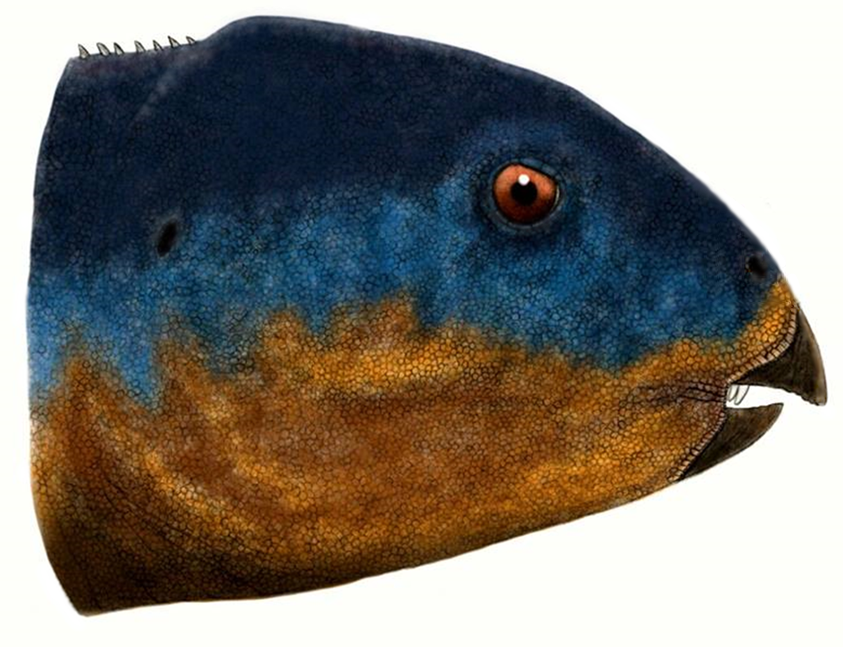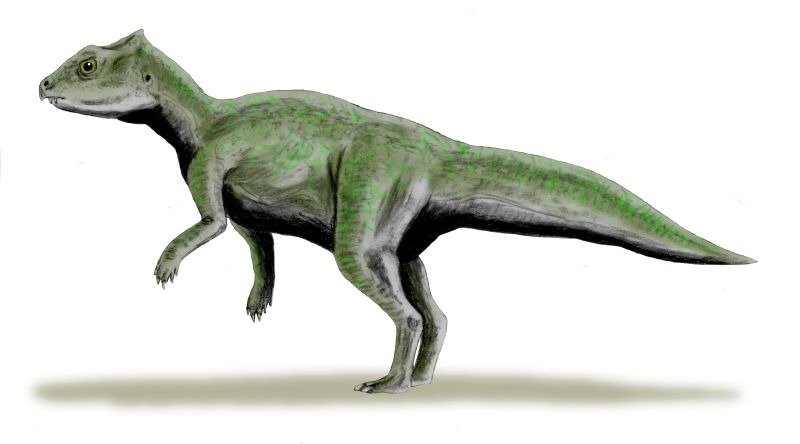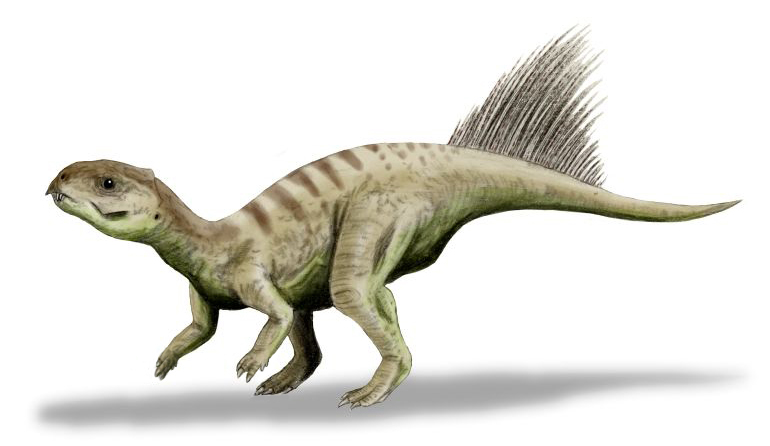|
Hualianceratops Wucaiwanensis2
''Hualianceratops'' is a genus of herbivorous ceratopsian dinosaur that lived about 160 million years ago in the Late Jurassic epoch in what is now western China. The single species, ''H. wucaiwanensis'' was described in 2015. Its size has been compared to that of a spaniel. Discovery In 2002, an expedition by the Institute of Vertebrate Paleontology and Paleoanthropology and the George Washington University in the region of Wucaiwan in Xinjiang discovered the skeleton of a small dinosaur. The fossil was prepared by Xiang Lishi, Yu Tao and Ding Xiaoqing. In 2015, the type species ''Hualianceratops wucaiwanensis'' was named and described by Han Fenglu, Catherine A. Forster, James M. Clark, and Xu Xing. The generic name combines the Chinese ''hua'', "ornamental", and ''lian'', "face", a reference to the ornamentation of the jaw bones, with ''ceratops'', Latinised Greek for "hornface", a usual suffix in the names of ceratopsians. The specific name refers to the provenance at ... [...More Info...] [...Related Items...] OR: [Wikipedia] [Google] [Baidu] |
Late Jurassic
The Late Jurassic is the third epoch of the Jurassic Period, and it spans the geologic time from 163.5 ± 1.0 to 145.0 ± 0.8 million years ago (Ma), which is preserved in Upper Jurassic strata.Owen 1987. In European lithostratigraphy, the name "Malm" indicates rocks of Late Jurassic age. In the past, ''Malm'' was also used to indicate the unit of geological time, but this usage is now discouraged to make a clear distinction between lithostratigraphic and geochronologic/chronostratigraphic units. Subdivisions The Late Jurassic is divided into three ages, which correspond with the three (faunal) stages of Upper Jurassic rock: Paleogeography During the Late Jurassic Epoch, Pangaea broke up into two supercontinents, Laurasia to the north, and Gondwana to the south. The result of this break-up was the spawning of the Atlantic Ocean. However, at this time, the Atlantic Ocean was relatively narrow. Life forms of the epoch This epoch is well known for many famous types of dinosau ... [...More Info...] [...Related Items...] OR: [Wikipedia] [Google] [Baidu] |
Xu Xing (paleontologist)
Xu Xing (; born July 1969) is a Chinese paleontologist who has named more dinosaurs than any other living paleontologist. Such dinosaurs include the Jurassic ceratopsian ''Yinlong'', the Jurassic tyrannosauroid ''Guanlong'', the large oviraptorosaur ''Gigantoraptor'', and the troodontid '' Mei''. Biography Xing was born in Xinjiang, China, in 1969. A graduate from the department of geology of Peking University, he is currently a researcher at the Institute of Vertebrate Paleontology and Paleoanthropology of the Chinese Academy of Sciences in Beijing. He had originally planned to become an economist. However, he was assigned to the department of geology by the Chinese authorities. He graduated in 1995, and claims inspiration from Roy Chapman Andrews. Among Xu's paleontological contributions have been discovery and analysis of dinosaur fossils with avian characteristics, and development of theories in regarding the evolution of feather Feathers are epidermal growths that for ... [...More Info...] [...Related Items...] OR: [Wikipedia] [Google] [Baidu] |
Yinlong
''Yinlong'' (, meaning "hidden dragon") is a genus of basal ceratopsian dinosaur from the Late Jurassic Period of central Asia. It was a small, primarily bipedal herbivore. Discovery and species A coalition of American and Chinese paleontologists, including Xu Xing, Catherine Forster, Jim Clark, and Mo Jinyou, described and named ''Yinlong'' in 2006. The generic name is derived from the Mandarin Chinese words 隱 (''yǐn'': "hidden") and 龍 (''lóng'': "dragon"), a reference to the movie ''Crouching Tiger, Hidden Dragon'', large portions of which were filmed in the western Chinese province of Xinjiang, near the locality where this animal's fossil remains were discovered. ''Long'' is the word most often used in the Chinese media when referring to dinosaurs. The species was named after the American vertebrate paleontologist William Randall Downs III, a frequent participant in paleontological expeditions to China who died the year before ''Yinlong'' was discovered.Xu, X., Forster, ... [...More Info...] [...Related Items...] OR: [Wikipedia] [Google] [Baidu] |
Chaoyangsaurus
''Chaoyangsaurus'' (" Chaoyang lizard") is a marginocephalian dinosaur from the Late Jurassic of China. It has been dated to between 150.8 and 145.5 million years ago. ''Chaoyangsaurus'' belonged to the Ceratopsia (Greek for "horned faces"). ''Chaoyangsaurus'', like all ceratopsians, was primarily a herbivore. Discovery and naming In 1976, the remains of ''Chaoyangsaurus'' were found by Cheng Zhengwu at Ershijiazi, in the Chaoyang area of Liaoning Province in northeastern China. The fossil was added to a travelling exhibition. Unlike many other dinosaurs, ''Chaoyangsaurus'' had been discussed in a number of sources before its official publication. As a result of this, several different spellings of its name have come and gone as invalid ''nomina nuda'' ("naked names", names with no formal description behind them). The first name to see print was ''Chaoyoungosaurus'', which appeared in the guidebook to a Japanese museum exhibit, and was the result of an incorrect transliteration ... [...More Info...] [...Related Items...] OR: [Wikipedia] [Google] [Baidu] |
Quadratojugal Bone
The quadratojugal is a skull bone present in many vertebrates, including some living reptiles and amphibians. Anatomy and function In animals with a quadratojugal bone, it is typically found connected to the jugal (cheek) bone from the front and the squamosal bone from above. It is usually positioned at the rear lower corner of the cranium. Many modern tetrapods lack a quadratojugal bone as it has been lost or fused to other bones. Modern examples of tetrapods without a quadratojugal include salamanders, mammals, birds, and squamates (lizards and snakes). In tetrapods with a quadratojugal bone, it often forms a portion of the jaw joint. Developmentally, the quadratojugal bone is a dermal bone in the temporal series, forming the original braincase. The squamosal and quadratojugal bones together form the cheek region and may provide muscular attachments for facial muscles. In reptiles and amphibians In most modern reptiles and amphibians, the quadratojugal is a prominent, strapl ... [...More Info...] [...Related Items...] OR: [Wikipedia] [Google] [Baidu] |
Quadrate Bone
The quadrate bone is a skull bone in most tetrapods, including amphibians, sauropsids (reptiles, birds), and early synapsids. In most tetrapods, the quadrate bone connects to the quadratojugal and squamosal bones in the skull, and forms upper part of the jaw joint. The lower jaw articulates at the articular bone, located at the rear end of the lower jaw. The quadrate bone forms the lower jaw articulation in all classes except mammals. Evolutionarily, it is derived from the hindmost part of the primitive cartilaginous upper jaw. Function in reptiles In certain extinct reptiles, the variation and stability of the morphology of the quadrate bone has helped paleontologists in the species-level taxonomy and identification of mosasaur squamates and spinosaurine dinosaurs. In some lizards and dinosaurs, the quadrate is articulated at both ends and movable. In snakes, the quadrate bone has become elongated and very mobile, and contributes greatly to their ability to swallow very ... [...More Info...] [...Related Items...] OR: [Wikipedia] [Google] [Baidu] |
Jugal Bone
The jugal is a skull bone found in most reptiles, amphibians and birds. In mammals, the jugal is often called the malar or zygomatic. It is connected to the quadratojugal and maxilla, as well as other bones, which may vary by species. Anatomy The jugal bone is located on either side of the skull in the circumorbital region. It is the origin of several masticatory muscles in the skull. The jugal and lacrimal bones are the only two remaining from the ancestral circumorbital series: the prefrontal, postfrontal, postorbital, jugal, and lacrimal bones. During development, the jugal bone originates from dermal bone. In dinosaurs This bone is considered key in the determination of general traits in cases in which the entire skull has not been found intact (for instance, as with dinosaurs in paleontology). In some dinosaur genera the jugal also forms part of the lower margin of either the antorbital fenestra or the infratemporal fenestra, or both. Most commonly, this bone articu ... [...More Info...] [...Related Items...] OR: [Wikipedia] [Google] [Baidu] |
Autapomorphies
In phylogenetics, an autapomorphy is a distinctive feature, known as a derived trait, that is unique to a given taxon. That is, it is found only in one taxon, but not found in any others or outgroup taxa, not even those most closely related to the focal taxon (which may be a species, family or in general any clade). It can therefore be considered an apomorphy in relation to a single taxon. The word ''autapomorphy'', first introduced in 1950 by German entomologist Willi Hennig, is derived from the Greek words αὐτός, ''autos'' "self"; ἀπό, ''apo'' "away from"; and μορφή, ''morphḗ'' = "shape". Discussion Because autapomorphies are only present in a single taxon, they do not convey information about relationship. Therefore, autapomorphies are not useful to infer phylogenetic relationships. However, autapomorphy, like synapomorphy and plesiomorphy is a relative concept depending on the taxon in question. An autapomorphy at a given level may well be a synapomorphy at ... [...More Info...] [...Related Items...] OR: [Wikipedia] [Google] [Baidu] |
Oxfordian (stage)
The Oxfordian is, in the ICS' geologic timescale, the earliest age of the Late Jurassic Epoch, or the lowest stage of the Upper Jurassic Series. It spans the time between 163.5 ± 1.0 Ma and 157.3 ± 1.0 Ma (million years ago). The Oxfordian is preceded by the Callovian and is followed by the Kimmeridgian. Stratigraphic definitions The Oxfordian Stage was called "Clunch Clay and Shale" by William Smith (1815–1816); in 1818 W. Buckland described them under the unwieldy title "Oxford, Forest or Fen Clay". The term Oxfordian was introduced by Alcide d'Orbigny in 1844. The name is derived from the English city of Oxford, where the beds are well developed, but they crop out almost continuously from Dorset to the coast of Yorkshire, generally forming low, broad valleys. They are well exposed at Weymouth, Oxford, Bedford, Peterborough, and in the cliffs at Scarborough, Red Cliff and Gristhorpe Bay. Rocks of this age are found also in Uig and Skye. The base of the Oxfordian Stage ... [...More Info...] [...Related Items...] OR: [Wikipedia] [Google] [Baidu] |
Shishugou Formation
The Shishugou Formation () is a geological formation in Xinjiang, China. Its strata date back to the Late Jurassic period. Dinosaur remains are among the fossils that have been recovered from the formation.Weishampel, David B; et al. (2004). "Dinosaur distribution (Late Jurassic, Asia)." In: Weishampel, David B.; Dodson, Peter; and Osmólska, Halszka (eds.): The Dinosauria, 2nd, Berkeley: University of California Press. Pp. 550–552. . The Shishugou Formation is considered one of the most phylogenetically and trophically diverse Middle to Late Jurassic theropod fauna. The Wucaiwan Member, once considered a separate, underlying formation,Weishampel, David B; et al. (2004). "Dinosaur distribution (Middle Jurassic, Asia)." In: Weishampel, David B.; Dodson, Peter; and Osmólska, Halszka (eds.): The Dinosauria, 2nd, Berkeley: University of California Press. Pp. 541–542. . is now considered the lowest unit of the Shishugou Formation. Lithology At the Wuwaican locality, the formati ... [...More Info...] [...Related Items...] OR: [Wikipedia] [Google] [Baidu] |
Holotype
A holotype is a single physical example (or illustration) of an organism, known to have been used when the species (or lower-ranked taxon) was formally described. It is either the single such physical example (or illustration) or one of several examples, but explicitly designated as the holotype. Under the International Code of Zoological Nomenclature (ICZN), a holotype is one of several kinds of name-bearing types. In the International Code of Nomenclature for algae, fungi, and plants (ICN) and ICZN, the definitions of types are similar in intent but not identical in terminology or underlying concept. For example, the holotype for the butterfly '' Plebejus idas longinus'' is a preserved specimen of that subspecies, held by the Museum of Comparative Zoology at Harvard University. In botany, an isotype is a duplicate of the holotype, where holotype and isotypes are often pieces from the same individual plant or samples from the same gathering. A holotype is not necessarily "typ ... [...More Info...] [...Related Items...] OR: [Wikipedia] [Google] [Baidu] |
Life Science Identifier
Life Science Identifiers are a way to name and locate pieces of information on the web. Essentially, an LSID is a unique identifier for some data, and the LSID protocol specifies a standard way to locate the data (as well as a standard way of describing that data). They are a little like DOIs used by many publishers. An LSID is represented as a uniform resource name (URN) with the following format: * urn:lsid::: The ''lsid:'' namespace, however, is not registered with the Internet Assigned Numbers Authority (IANA), and so these are not strictly URNs or URIs. LSIDs may be resolved in URLs, e.g. http://zoobank.org/urn:lsid:zoobank.org:pub:CDC8D258-8F57-41DC-B560-247E17D3DC8C Controversy over the use of LSIDs There has been a lot of interest in LSIDs in both the bioinformatics and the biodiversity communities, with the latter continuing to use them as a way of identifying species in global catalogues. However, more recently, as understanding has increased of how HTTP URIs can perfo ... [...More Info...] [...Related Items...] OR: [Wikipedia] [Google] [Baidu] |





.jpg)

